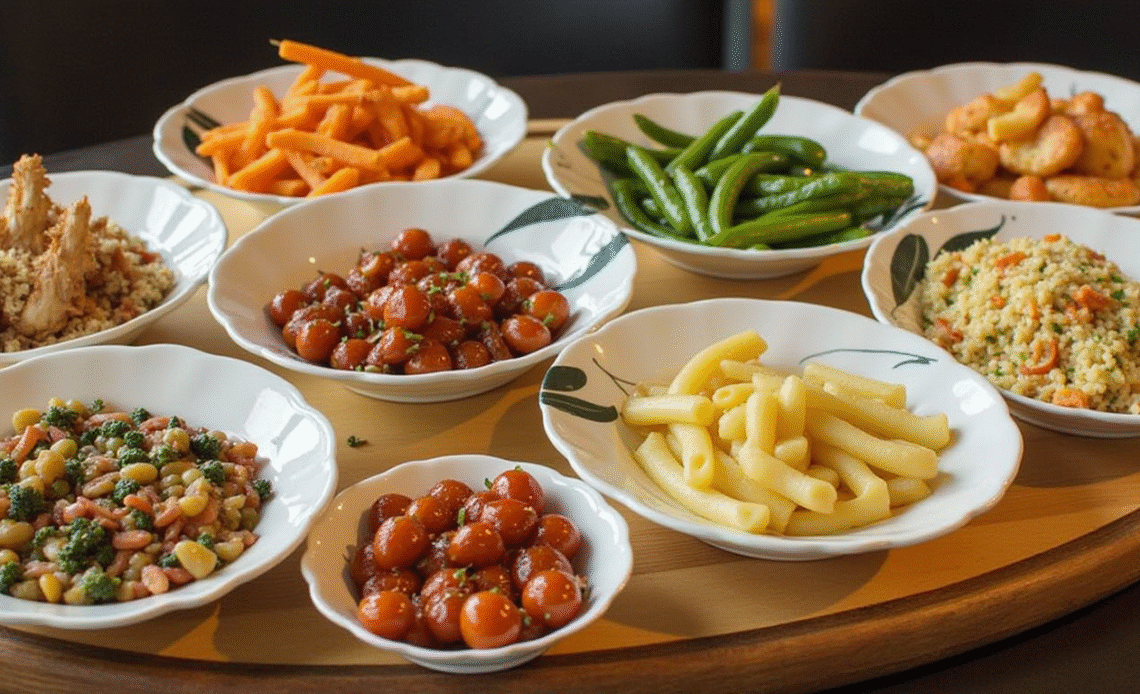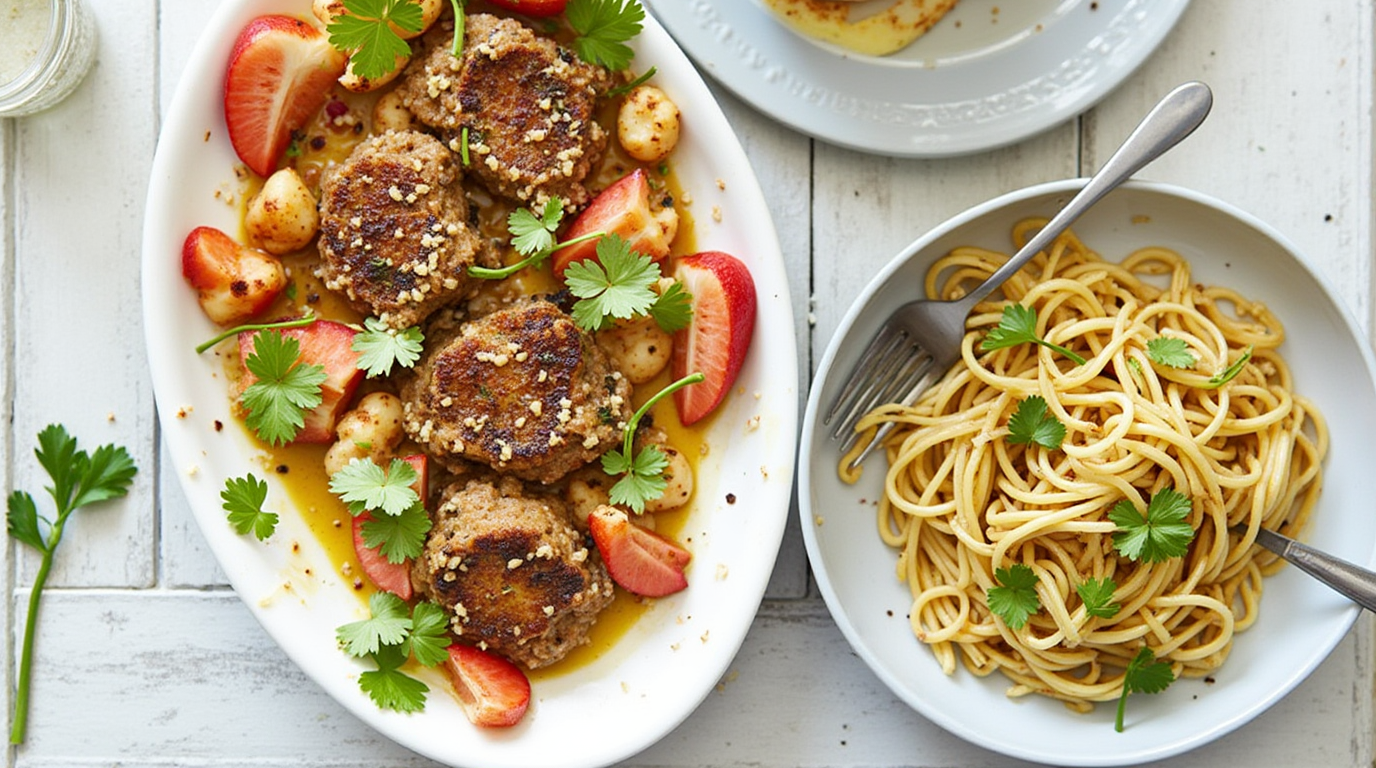
Introduction: The Ever-Evolving Plate
The world of food is in perpetual motion, a dynamic culinary landscape constantly reshaped by innovation, cultural exchange, and shifting consumer desires.
Every year brings a fresh wave of excitement, introducing novel ingredients, ingenious cooking methods, and entirely new ways to experience flavors and textures.
As we look towards 2025, a fascinating array of developments is converging, giving rise to what we can aptly term “Rising Recipes.” This concept extends far beyond mere lists of popular dishes; it encapsulates the broader currents transforming how we eat, cook, and even think about food.
These rising recipes are born from the interplay of emerging ingredients discovered or rediscovered, innovative techniques made accessible through technology, evolving health priorities influencing our choices, and the rich tapestry of global cultures increasingly finding expression on our plates.
The coming year promises to be particularly significant for culinary innovation, a time when advancements in food technology, a heightened focus on sensory experiences like texture, a deeper commitment to wellness, the embrace of diverse global flavors, and even the social aspects of eating converge to create a truly exciting future of food. Prepare to explore the key food trends of 2025, uncovering the rising recipes that will define our culinary experiences and offer thrilling new possibilities for both passionate home cooks and discerning diners navigating this ever-evolving plate.
2. The Texture Revolution: Crunch, Crisp, and Concentrated Flavors
Beyond taste and aroma, texture is rapidly ascending as a crucial element in the modern culinary experience, and 2025 is set to amplify this trend through fascinating innovations.
Leading this charge is the surprising resurgence and reimagining of freeze-drying technology. Once primarily associated with astronaut meals or long-shelf-life backpacking provisions, advancements have made freeze-drying more energy-efficient and affordable, unlocking its potential for creating delightful, everyday treats.
The process works by removing nearly all moisture from food under vacuum conditions, resulting in a uniquely light, airy, and often intensely crunchy texture, reminiscent of the beloved marshmallows found in breakfast cereals like Lucky Charms.
This transformation doesn’t just alter texture; it also concentrates the food’s original flavors and often enlarges its physical size, adding a visual novelty factor. The appeal is multi-faceted: it offers a completely new sensory experience, satisfies cravings for crunch, and provides an affordable way to try something different and exciting.
We’re seeing this explode in popularity, particularly with sweets. Companies like the TikTok-viral Sweety Treaty Co are gaining massive followings for their freeze-dried gummy bears, peach rings, and other candies, while brands such as Freezecake are applying the technique to create crunchy cheesecake bites.
This texture revolution isn’t just about snacks, however. It signals a broader shift where texture is becoming a primary consideration in recipe development. These novel freeze-dried items could become innovative components in desserts, breakfast bowls, or even savory dishes needing a surprising textural counterpoint.
The rise of freeze-dried treats underscores a key aspect of rising recipes in 2025: the deliberate manipulation and celebration of texture to create more engaging and memorable food experiences, moving far beyond simple sustenance towards multi-sensory delight.
3. Tech Takes the Kitchen: Smart Shopping and Single-Task Stars

Technology continues its relentless march into every corner of our lives, and the kitchen is no exception. In 2025, two significant tech trends are reshaping how we approach food, from initial planning and shopping to the final preparation: the integration of Artificial Intelligence (AI) into grocery shopping and the charming rise of specialized, single-task appliances.
AI is moving beyond novelty and becoming a genuinely useful tool for the home cook. Major online grocery platforms like Walmart, Amazon, and Instacart have rolled out sophisticated AI-powered search features.
Instead of just matching keywords, these systems understand natural language queries, allowing users to ask things like, “What side dishes go well with salmon?” or “Suggest a quick weeknight meal using chicken breast and broccoli.”
The AI, trained on vast amounts of user data and purchasing behavior, returns increasingly personalized and relevant suggestions over time, streamlining meal planning and potentially reducing food waste by suggesting recipes based on ingredients you already have or frequently buy.
This intelligence isn’t confined to the digital realm; AI-powered smart shopping carts are beginning to appear in physical stores. These carts automatically track items added or removed, potentially offering real-time budget tracking, highlighting promotions, and even gamifying the shopping experience, making the mundane task more engaging and efficient.
Complementing this smart shopping trend is the burgeoning popularity of “one-trick” appliances. These are typically small, often aesthetically pleasing gadgets designed to perform a single function exceptionally well, bringing a touch of joy and simplicity to the kitchen.
The undisputed star of this trend has been the TikTok-famous Ninja Creami, which transforms simple bases into customized soft-serve ice cream, sorbet, or milkshakes with minimal effort. Unlike bulky, traditional ice cream makers, the Creami is compact and user-friendly.
Other examples include the ubiquitous and affordable Dash Mini Waffle Maker, perfect for single servings. This trend reflects a post-inflation consumer mindset, where spending shifts towards smaller, joyful purchases or “little treats.” These appliances are easy to use, easy to store, and often gain viral status through social media creators showcasing their capabilities on platforms like TikTok and linking them in their Amazon storefronts.
Together, these technological developments are fundamentally influencing rising recipes. AI simplifies discovery and procurement, while single-task appliances make specific techniques more accessible, encouraging experimentation and the creation of recipes tailored to these new tools. Technology in 2025 isn’t just about automation; it’s about enhancing creativity and convenience in the kitchen.
4. Wellness Reimagined: Nutrient Density and Functional Foods
The pursuit of wellness continues to be a powerful driver in food choices, but the focus in 2025 is evolving towards a more nuanced understanding of nutrition, emphasizing nutrient density and the functional benefits of food.
This shift is partly influenced by the growing population using GLP-1 weight loss medications (like Ozempic or Wegovy), who often experience reduced appetite and therefore seek smaller, highly concentrated sources of essential nutrients.
However, the trend extends beyond this specific group, reflecting a broader societal interest in optimizing health through diet. Consumers are increasingly looking for meals and snacks packed with protein, fiber, vitamins, and minerals, but in manageable portions that align with satiety signals rather than oversized servings.
The food industry is responding proactively. Major CPG companies are launching product lines specifically designed to meet these needs; for instance, Nestle introduced Vital Pursuit, a range of frozen meals tailored for GLP-1 users, focusing on high protein, fiber, and essential nutrients in appropriate portion sizes.
Similarly, services like Daily Harvest have debuted GLP-1 support meals. This focus on nutrient density might also ripple outwards, influencing household eating patterns. Individuals managing their weight or health goals may shift their family’s grocery shopping away from processed options and fast food towards whole foods and thoughtful meal preparation, impacting breakfast, lunch, dinner, and snacks.
Parallel to this is the rise of “brain food” for kids. This trend reflects a parenting style often described as “intensive parenting,” where significant focus is placed on optimizing child development through various means, including nutrition. Food brands are positioning products not just as tasty snacks but as tools for cognitive support.
Companies like Cerebelly and Brainiac Foods explicitly market their products, often pouches or snack bars, as containing “brain-supporting nutrients” like Omega-3s (DHA), choline, and specific vitamins linked to cognitive function.
While the direct impact of these specific products is debated, the trend highlights parents’ willingness to invest in foods perceived as beneficial for their children’s development, especially given concerns about modern parenting pressures, as noted in advisories on youth mental health.
These wellness-focused trends significantly shape the landscape of rising recipes. We see an increasing demand for recipes that are not just healthy but functionally optimized – designed to maximize nutrient intake per calorie, support specific health goals (like weight management or cognitive function), and incorporate ingredients known for their beneficial properties. Mindful portioning and the integration of whole, unprocessed ingredients are becoming hallmarks of modern wellness cooking in 2025.
5. A World on a Plate: Global Flavors and Plant-Based Progress
The culinary landscape of 2025 is becoming increasingly interconnected, bringing exciting global flavors to the forefront while simultaneously pushing the boundaries of plant-based cuisine. Two notable trends exemplify this: the vibrant ascent of calamansi and the sophisticated evolution of plant-based deli meats.
Calamansi, also known as calamondin or Philippine lime, is a small citrus fruit that has long been a staple in Filipino and Southeast Asian cooking.
Its unique flavor profile – a bright, intensely tart blend reminiscent of lemon, lime, and orange – is capturing the attention of chefs and product developers worldwide.
Previously niche, calamansi is now “popping off,” appearing in mainstream supermarket products like Trader Joe’s Calamansi and Mango Sorbet and featuring prominently on high-end restaurant menus across diverse culinary scenes.
Its versatility was even showcased in Food Network’s Harry Potter: Wizards of Baking, where a chef incorporated calamansi custard into an elaborate cake. This growing visibility suggests we can expect to see calamansi infused into more big-brand snack flavors, beverages, sauces, and fast-casual dining options, making this distinct Southeast Asian taste more accessible to global palates.
Alongside this exploration of global ingredients, the plant-based sector is undergoing a significant refinement.
While overall sales of some meat alternatives have seen fluctuations, often attributed to price and texture challenges, the category of plant-based deli meats is experiencing notable growth.
This sub-category seems less sensitive to price premiums, perhaps because consumers are already accustomed to paying more for conventional sliced deli meats and charcuterie. Brands are moving beyond simple soy or wheat-based formulations, launching innovative products using less-processed proteins and achieving more convincing textures and flavors.
A prime example is Prime Roots, which utilizes Koji – a type of Japanese fermented rice revered by Michelin-star chefs for its deep umami flavor – as the base for its deli slices.
Their products boast no nitrates, preservatives, cholesterol, soy, or wheat, appealing to health-conscious consumers and replicating the deli experience effectively, even landing behind traditional deli counters in some stores. This signifies not the “death” of the plant-based industry, as some have speculated, but rather its maturation.
The focus is shifting towards higher quality, better taste, and more sophisticated applications that mimic traditional products more closely.
These trends demonstrate how rising recipes in 2025 are embracing both authenticity in global flavors and ingenuity in plant-based alternatives, offering diverse and exciting options for a broadening range of dietary preferences and culinary curiosities.
6. Food as Connection: The Resurgence of Social Cooking
In an increasingly digital world, where interactions often feel fleeting and mediated through screens, there’s a growing yearning for tangible connection and shared experiences.
Food, in its fundamental role as a communal element, is becoming a powerful catalyst for rebuilding these connections in 2025, most notably through the resurgence of cookbook clubs.
Spreading from major cities like NYC and London to smaller communities in between, these clubs offer a refreshing antidote to online saturation. The concept is simple yet effective: members collectively choose a cookbook, each person selects and prepares a different recipe from it, and then they gather for a potluck-style meeting to share the dishes and discuss their cooking experiences.
Ina Garten’s cookbooks are reportedly popular choices, but the specific book matters less than the act of collective culinary exploration. This trend, gaining visibility on platforms like TikTok, ironically leverages digital reach to promote decidedly offline, in-person gatherings.
As cookbook club founder Stephanie Lau noted in an interview with Food Network, “Scrolling online is not really tangible.” People crave genuine interaction, the opportunity to taste diverse foods prepared by others, and the simple pleasure of sharing a meal together.
These clubs hark back to a time before dinner party trends became overly complex or performative; they offer a relaxed, accessible space for people who love food and cooking to connect.
Cookbook clubs represent more than just a way to try new recipes; they signify a broader social shift where food evolves beyond mere sustenance or individual pursuit into a deliberate means of fostering community and combating the loneliness sometimes fostered by excessive online engagement.
They are creating new types of stranger gatherings centered around the shared joy of cooking and eating, highlighting how social dynamics are intrinsically linked to the rising recipes and food culture of 2025.
7. Synthesis: Defining the “Rising Recipes” of 2025
What, then, defines the “Rising Recipes” emerging in 2025? They are not confined to a single cuisine or cooking style but are characterized by a dynamic interplay of the trends we’ve explored.
Technology acts as both an enabler and an inspiration, simplifying grocery shopping through AI while introducing novel preparation methods via specialized appliances. Health consciousness drives a focus on nutrient density and functional ingredients, influencing portion sizes and recipe formulation.
The global pantry continues to expand, bringing formerly niche ingredients like calamansi into the mainstream, while plant-based options evolve with sophisticated techniques using ingredients like Koji.
Texture is elevated to a key sensory component, celebrated through innovations like freeze-drying. And underpinning it all is a renewed appreciation for food as a means of social connection, fostering community through shared culinary experiences like cookbook clubs.
The rising recipes of 2025 are adaptable, innovative, and multi-sensory, reflecting a holistic approach to food that values wellness, global awareness, technological integration, and the simple joy of eating together.
8. Conclusion: Your Culinary Future
The culinary world in 2025 is brimming with potential, shaped by the exciting rising recipes and trends we’ve explored.
From the textural marvels of freeze-dried treats and the smart assistance of AI in our kitchens to the focus on nutrient-dense wellness, the vibrant flavors of global ingredients like calamansi, sophisticated plant-based options, and the heartwarming connections forged over shared meals in cookbook clubs – the future of food is diverse, dynamic, and deeply engaging. Don’t just observe these changes; embrace them.
Let these trends inspire you to experiment in your own kitchen, to seek out new flavors and techniques, and ultimately, to discover and define your own personal rising recipes for the year ahead. The culinary adventure awaits.
